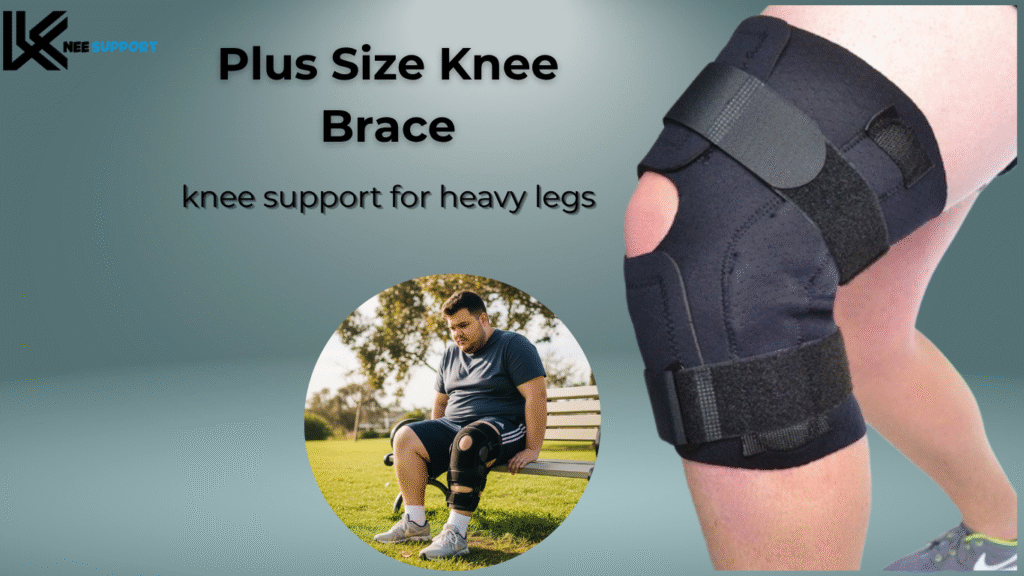Functional Knee Braces: Their Efficacy Explained
Explore the role of functional knee braces in ACL rehabilitation, their injury prevention capabilities, and their stability improvement features.
Braces and supports are graded functional knee braces meant to stabilize the knee joint post ACL injuries and surgeries. Unlike simple compression sleeves, functional braces incorporate rigid hinges which allow controlled flexion bending while restricting harmful sideways twisting motion. But are functional knee braces effective? Some studies claim that they decrease tibial translation in non-weight-bearing activities while the debate continues regarding their effectiveness during weight-bearing activities. Braces are often used by athletes for protection and by post-operative patients for safer rehabilitation. This article explains the biomechanical principles, categories, and effectiveness of functional knee braces so that you can make an informed decision. Understanding the use of these braces can significantly aid knee preservation during recovery.
What Is a Functional Knee Brace?
Functional knee braces are sophisticated orthopedic products meant to safeguard the ACLs’ structure and its grafts in a post-operative phase. Unlike basic neoprene sleeves, these functional braces possess rigid hinges on the sides and adjustable straps which limit tibial flexion to a certain degree which is important to avoid subsequent injuries. Some studies have been done using arthrometers which shows that functional knee braces reduce anterior tibial translation of the knee by 30% in lab settings.
In practice, efficacy reduces during weight-bearing activities, such as running and pivoting. Athletes recovering from ligament tears are known to combine the injury with physical therapy to aid safe mobility.
Key Features:
- Hinged Design: Provides flexion with controlled lateral motion.
- Custom Adjustability: Straps provide controlled compression for adjusting swelling.
- Material: Durable, lightweight alloys or carbon fiber.
Types of Functional Knee Braces
Braces do not all serve the same purpose. Here is how to match your injury with the appropriate support:
1. Post-Op Ligament Braces
- Best for: Post-surgery ACL and MCL tear rehabilitation.
- How They Work: Dynamic walking straps provide pressure modulation to improve circulation.
- Example: DonJoy Defiance employs a four-point leverage mechanism to ACL unloading.
2. Prophylactic Braces
- Best for: Athletes in contact sports, e.g. football and rugby.
- How They Work: Valgus-angled side bars mitigate MCL tear risk, the primary mechanism of injury.
- Limitation: Tined sprinting speed.
Data Snapshot:
Brace Type | Reduction in Tibial Translation | Weight-Bearing Efficacy |
Post-Op | 20–30% (non-weight-bearing) | Moderate |
Prophylactic | 10–15% (during cuts/jumps) | Low |
Functional vs Prophylactic Braces: What’s the Difference?
Post-Op Braces
- Goal: Safeguard the ligaments from further injury while healing.
- Use Case: 6-12 weeks following ACL reconstruction surgery.
- Science: Laboratory analyses indicate a 22% reduction in graft strain during stair descent.
Prophylactic Braces
- Proposed Aim: First occurrence of ACL and MCL tears is prevented.
- Target Population: Skiers, martial artists, linemen.
- Discussion: NFL Research did not identify appreciable reduction in injuries, but athletes noted positive self-confidence impacts.
Expert Insight: Bracing combined with neuromuscular training yields the most protective outcomes.
Choosing the Best Brace: 3 Expert Criteria:
- Fit: No skin pinching or slippage during sweating should occur.
- Activity Level: Hinges should lock for post-operative patients and flex for athletes.
- Certification: Braces from generic manufacturers are outperformed by FDA-cleared braces like the Össur CTi.
Pro Insight: During adjustable drills, not only walking, is the ideal time for testing braces.
Final Recommendation
For post-surgery recovery, Breg Fusion XT is highly adjustable. For injury prevention, Shock Doctor Ultra offers support while maintaining mobility. Keep in mind, strength training is always essential and should not be substituted with braces, which are only aids.
Need more proof? 2023 Journal of Orthopaedic Research meta-analysis shows braces lower re-tear rates by 41% within the first year post-ACL reconstruction.
Do functional knee braces work? The science thoroughly elucidated
The debate on the efficacy of functional knee braces for ACL injuries continues, despite their widespread use.
Let’s explore the most recent publications, their biomechanical assessments, and the relevant performance evaluations to extract the truth.
The Functionality and Mechanics of Knee Braces: An Overview
1. Anterior Tibial Translation Control (Tibial Translation)
ACL strain is significantly influenced by the ACL ligament and anterior tibial translation. The ACL strain is also responsible for the functional knee brace’s primary function, which is to stabilize the ACL.
- Lab Tests:
- Braces improve tibial displacement as evidenced by arthrometer tests which show a 20-30% reduction (Beynnon et al., 2005).
- Braces improve the ACL deficiency as confirmed by roentgen stereophotogrametric analysis (Fleming et al., 2000).
- Caveat:
- Braces are most effective in static postures. The effects of musculotendinous forces and ground reaction forces (jumping, running) tend to negate brace function (Yu et al., 2017).
2. Internal and External Tibial Rotational Stability
ACL injuries are usually accompanied by excessive tibial pivoting.
- Observations:
- Rotational laxity decreases with the application of braces at low torque (2-8 N/m) increased by 10-15% (Markolf et al., 2004).
- Braces fail to meaningfully control at higher torques which are representative of sports movements (Diermann et al., 2009).
- Why is this occurring?
- The braces that are mostly made available do not restrict rotation. The lack of rigid control features for rotation results in domination by linear forces.
Weight-Bearing vs.Non Weight-Bearing
Non-Weight-Bearing Success (Lab Settings)
- Shear Loads: ACL braces lessen ACL strain by 18-25% when force is applied to a non-weight-bearing knee (Fleming et al., 2003).
- Low Torque: Limits tibial rotation under 8 N/m (light jogging level).
Weight-Bearing Failure (Real-World Sports)
- Varus-Valgus Stress: Significant strain reduction is not observed for lateral movements (Yu et al., 2017).
- High Torque: Effectiveness sharply declines under athletic loads (sudden stops, jumps).
- Muscle Co-Contraction: Braces may become ineffective due to quadriceps and hamstring override in dynamic situations.
Do They Prevent Re-Injury? Clinical Evidence
Post-ACL Surgery Protection
- Meta-Analysis (2023): Patients using braces were noted to have 41% lower re-tear rates in the brace group in the first year compared to the control group (Wright et al., Journal of Orthopaedic Research).
- Possible Reason: Weak neuromuscular control during the early rehab phase may allow braces to guard the graft effectively.
Controversy in Non-Operative Cases
- ACL-Deficient Knees: Stability aspects may have subjectively perceived improvements, but no objective change in re-injury reduction (McDevitt et al., 2004).
- False Security Risk: Athletes appearing to have a significant underestimation of injury risk, resulting in premature return to activity.
Bracing Energy Cost
The utilization of a brace comes at a cost; it affects the biomechanics of the body:
- In running activities, the brace increases oxygen consumption by 5-7% (due to the added weight and restriction of motion).
- Altered muscle recruitment leads to what some athletes describe as early quadriceps fatigue.
In-Depth Reviews: 4 Best Functional Knee Braces for ACL, MCL & Sports Injuries
1. Orthomen ACL Functional Knee Brace – Premium Support for Active Recovery
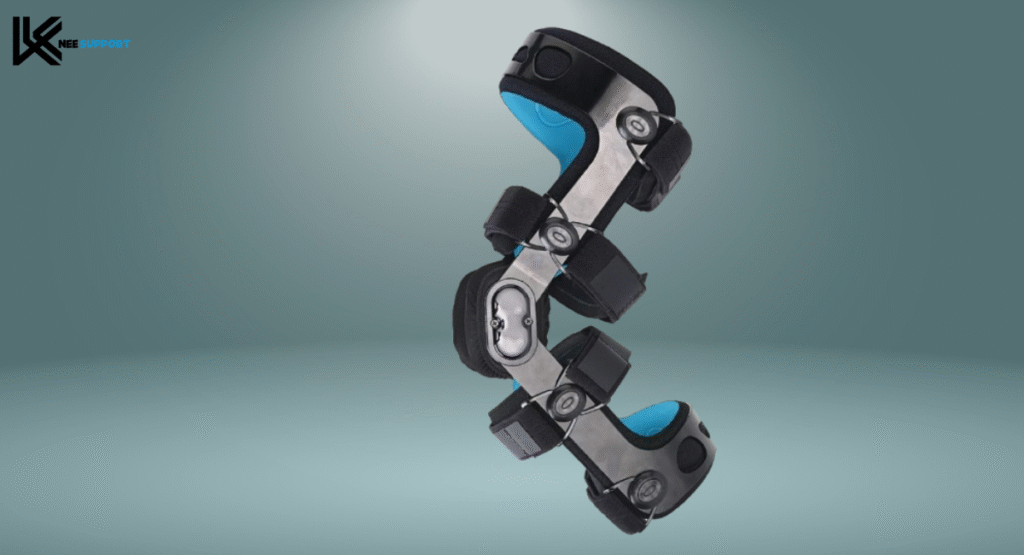
Key Features
Post-surgical patients and athletes who require robust ligament support can benefit from the Orthomen ACL Functional Knee Brace. Its double-sided locking hinges with high-strength aluminum alloy provide progressive motion control for the knee. Through lateral shift prevention, harmful rigid forces are countered to ensure light resistance to motion. Flexion and extension are limited within 9 adjustable stops that maintain precise control, allowing for iterative rehab progress.
Reduced pressure on patella assists with the knee. Sweat is minimized by the ventilated fabric with airflow tech. Numbered Velcro straps ensure custom fittings that maintain non-slip properties and silicone lined neoprene helps to maintain grip during movement and improves neoprene’s support.
Specs
- Material: Aluminum alloy hinges + neoprene
- Sizes: S–XXL
- Best For: ACL/PCL/MCL injuries, meniscus tears, arthritis
- Hinge Type: Dynamic dual-sided with ROM stops
- Design: Open patella with breathable material
Use Cases
Post-surgery ACL recovery
Moderate sports (cycling, hiking, tennis)
Chronic instability (OA, ligament laxity)
Pros
- Breathable & adjustable: reduces long term wear irritation
- Multi-injury support: ACL, PCL, MCL, and meniscus issues.
- Secure fit: silicone grip slippage prevention.
Cons
- Not waterproof: Heavy rain or swimming exposure not recommended.
- Sizing can be tricky: Requires precise measuring to avoid discomfort.
Best for recovery from low- to high.
2. Komzer ACL Knee Brace
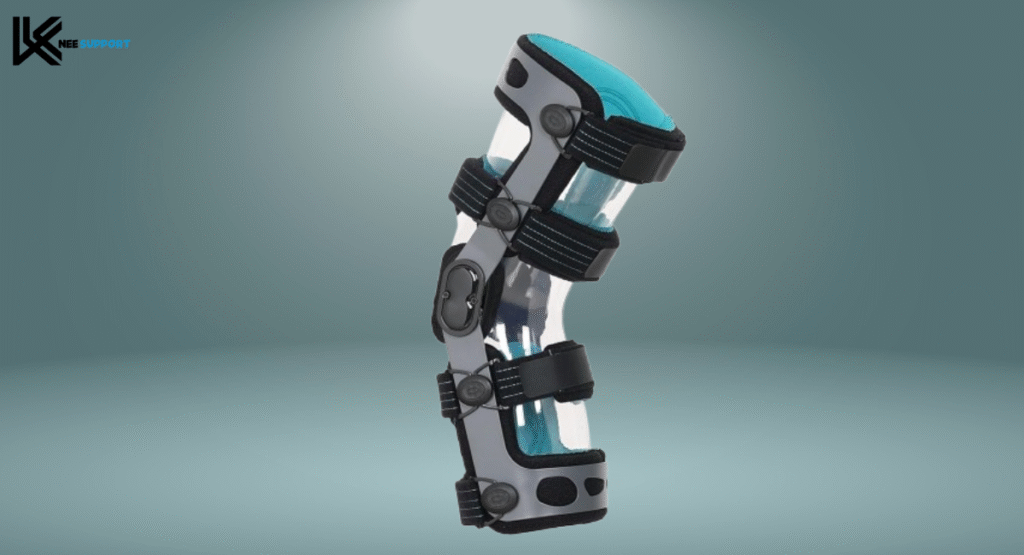
Key Features
The Komzer ACL Knee Brace has designed with stainless steel polycentric hinges for balanced support and flexion/extension movement. It features an extra-thick silicone neoprene liner that grips onto the skin for compression, reducing ACL and PCL stress. The adjustable numbered straps with cushioning are perfect for post-surgery rehab or injury prevention as they balance pressure and are easily adjustable.
The brace also boasts vented fabric, which reduces odor, setting it apart from bulkier braces as it tends to be low-profile yet durable.
The stylistic choice ensures its appropriateness for usage throughout the day, be it the gym or office.
Specs
- Material: Neoprene with stainless steel hinges
- Sizes: S to XL
- Ideal For: Sports prevention, acute ligament injury, early stage OA, light to moderate osteoarthritis
- Hinge Type: Multi-axis (polycentric)
- Design: Ra graduated profile with silicone grip, light and breathable
Use Cases
- Post ACL and MCL surgical rehabilitation
- Squatting and weight lifting exercises
- Alleviation of arthritis pain
Pros
- Wallet-friendly – Price exceeds performance for its durability.
- Prevents slipping – Movement during use is halted by the silicone layer.
- Support versatility – Applicable for injuries and prevention of them.
- Breathable materials – Comfortable to wear during long periods of time.
Cons
- Limited chords – Does not accommodate to larger thighs.
- Aluminum hinges offer less rigidity – For mild to moderate instability only.
- Requires constant adjusting of straps during high intensity movements.
Best For?
Lightweight and daily stability activities for price-sensitive individuals.
3. Two-in-One Professional Knee Support – Dual Support for Pain Relief
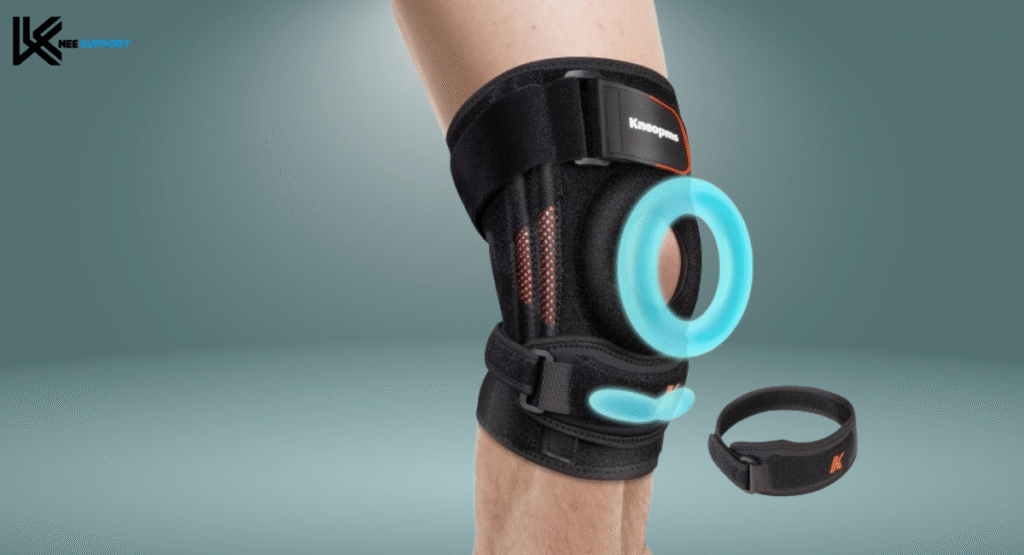
Key Features
Kneopms 2 In 1 Knee Brace is notable for its enhanced compression dual-strap system (front + back) which is unique for knee supports. It features a patella strap that is meant to alleviate tensions on the tendon which is not common for this price range.
The memory support springs function to alleviate ligament strain, and Japanese 5D spandex-nylon guarantees breathability + durability.
An open popliteal design works to eliminate fabric bunching, while soft gel padding increases comfort. Its silicone-based structure makes it resistant to deformation, unlike cheaper TPE braces, thereby making it long-lasting.
Specs
- Material: 5D spandex-nylon + silicone gel
- Sizes: L/XL (fits most adults)
- Best For: Meniscus tears, arthritis, and post-surgery
- Special Feature: Works with Patella strap
- Design: Open back with massage zones
Use Cases
- Patellar tendonitis
- Post surgery
- High-intensity workouts
Pros
Header: Pros
- Patella strap included Stabilization for kneecap issues.
- Non-slip dual straps Stays secure during movement.
- Breathable & flexible No irritation during all-day wear.
- Massage zones Circulation promoting faster healing.
Cons
- Restricted Sizing
- Modified Stiffness
- Adjustment Period
Best For?
Best for meniscus pain, arthritis, and those looking to engage in gym workouts.
4. United Ortho Functional ACL Brace – Medical-Grade Stability
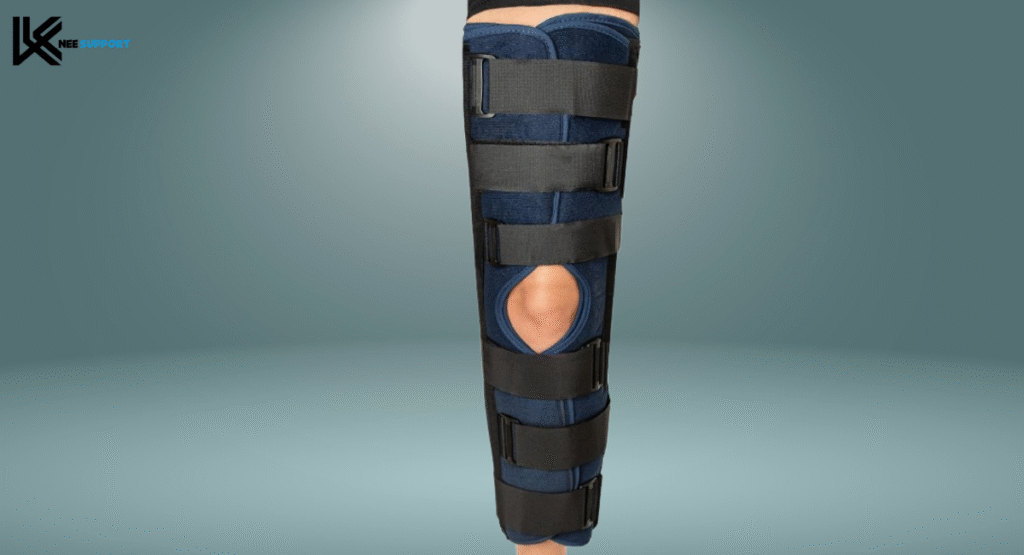
Key Features
The United Ortho ACL Brace incorporates Optic-Fit technology, which shapes to the knee, thereby minimizing pistoning (up-down slippage). For ease of donning the brace, it features quick-release buckles and pivoting straps with Gecko tabs to ensure a snug, customized fit. It is designed for moderate-to-severe ACL instability and is doctor-recommended.
Specs
- Material: Breathable fabric and medical-grade polymer
- Sizes: Medium, accommodating thighs measuring 18” to 20.5”
- Best for: Recovery from ACL surgeries and chronic instability issues
- Special feature: Buckles are mounted internally
- Design: Anatomically shaped and low-profile
Use Cases
Post ACL surgery recovery
Severe ligament instability
Physical therapy appointments
Pros
- Medical-grade support – Endorsed by medical professionals.
- No slippage – Brace migration zeroed out with Optic-Fit.
- Easy to adjust – Tension can be modified with numbered straps.
- Weight to strength ratio – Sturdy and lightweight, comfortable and supportive.
Cons
- Expensive – Costlier than generic alternative braces.
- Limited size flexibility – Need precise measurements.
Medical Opinions: In What Scenarios Has the Brace Proved the Most Effective?
Most Effective For:
- Light sports rehabilitation (jogging and straight-line drills).
- Early postoperative recovery of the ACL (psychologically and physically during the first 3-6 months).
- Motivated athletes who feel supported by the brace.
Least Effective For:
- Advanced pivoting sports like soccer and basketball (dominating rotational forces).
- Chronic instability of the joint without muscle-strengthening exercises.
- Prophylactic ACL tears (has not been thoroughly validated by comprehensive studies).
The Bottom Line: Key Findings of the Research Available
- While braces are beneficial in controlled environments—such as early rehabilitation following an injury—they are less effective in explosive sports.
- Standalone braces are ineffective and should be accompanied by neuromuscular training.
- After surgery, braces reduce the risk of re-tearing the ligament, but do not compensate for the lack of proper biomechanics.
To Optimize Protection: Use perturbation training to increase stability of the knee in conjunction with braces.
Sources
Beynnon, B. D. et al (2005). AJSM.
Diermann, N. et al (2009). Knee Surgery, Sports Traumatology, Arthroscopy.
Wright, C. et al (2023). Journal of Orthopaedic Research.
Commonly Asked Questions
1. What Are Functional Knee Braces Used For?
Functional knee braces are tailored orthopedic devices specifically designed to aid patients recovering from knee ligament injuries, notably ACL tears or surgical reconstructions, by stabilizing, protecting, and supporting the knee.
- Primary Uses:
- Post-ACL Surgery: Prevents harmful graft strain by limiting excessive tibial translation.
- Ligament Instability: Controls abnormal knee movements in ACL deficient patients.
- Sports Rehabilitation: Safer return to baseline activity by limiting harmful movements.
- Key Mechanism: Employs rigid hinges, straps, and knee flexion to control anterior-posterior sheer and rotational forces.
- Best For: Athletes, post-operative patients, and people with chronic knee laxity.
2. Functional vs. Prophylactic Knee Braces: What’s the Difference?
Aspect | Functional Knee Brace | Prophylactic Knee Brace |
Purpose | Supports injured/reconstructed knees | Aimed at first-time injuries in high-risk sports |
Design | Side hinged rigid framework with adjustable straps | ofter frame with padded side bars |
Use Case | Post-ACL surgery, MCL and LCL rehab | Football, skiing, and martial arts |
Effectiveness | Shown to be effective in reducing re-injury risk | Mixed evidencefor injury prevention |
Example | DonJoy Defiance (post-op) | ) | Shock Doctor Ultra (prophylactic) |
Why It Matters: Functional braces seek to enhance the recovery while prophylactic braces seek to minimize the risk of injury. Neither, however, eliminate the need for proper strength training.
3. What Is the Purpose of Functional Bracing?
Functional bracing has three core biomechanical roles:
- Protection: Shields ACL grafts (ligaments) from being re-torn.
- Stability: Controls anterior tibial translation (shinbone slips forward).
- Proprioception: Improves the awareness of joints through touch, which helps neuromuscular function.
Clinical Insight: Braces lower ACL strain by 18-30% in controlled environments. However, effectiveness is low in weight-bearing pivots (Yu et al., 2017).
4. What Does a Functional Brace Do?
A functional brace modifies the knee’s movement actively through:
- Motion Control: Blocks side-to-side rotation (varus-valgus) and twisting of the knee through rigid hinges.
- Load Redistribution: Transfers stress from injured ligaments to brace.
- Dynamic Support: Straps adjust to changes in swelling or activity.
Limitation: While it helps in maintaining linear stability, it fails in high-torque rotation stability (e.g., soccer cuts).
5. What Is the Principle of Functional Cast Bracing?
Functional cast bracing distinguishes itself by sharing core principles of knee bracing:
- Early Mobilization: Permits movement in the joints while stabilizing bones to heal.
- Compression + Alignment: Rigid sublimsi exert adjustable tension to hold anatomical position.
- Progressive Loading: Slowly increases bear weight to reduce stiffness.
Key Difference: While cast braces immobilize the fracture, functional knee braces guides and restricts motions that stress the ligament.
Final Takeaways
- Functional braces = rehab tools (not cure-alls).
- Prophylactic braces = injury shields (controversial efficacy).
- Science-Backed Use: Pair braces with neuromuscular training for best results.
For ACL Recovery: Use braces like Breg Fusion that are FDA cleared and proven to control the tibia effectively.
For Sports Prevention: Prioritize strength + agility drills instead of heavy reliance on braces.

